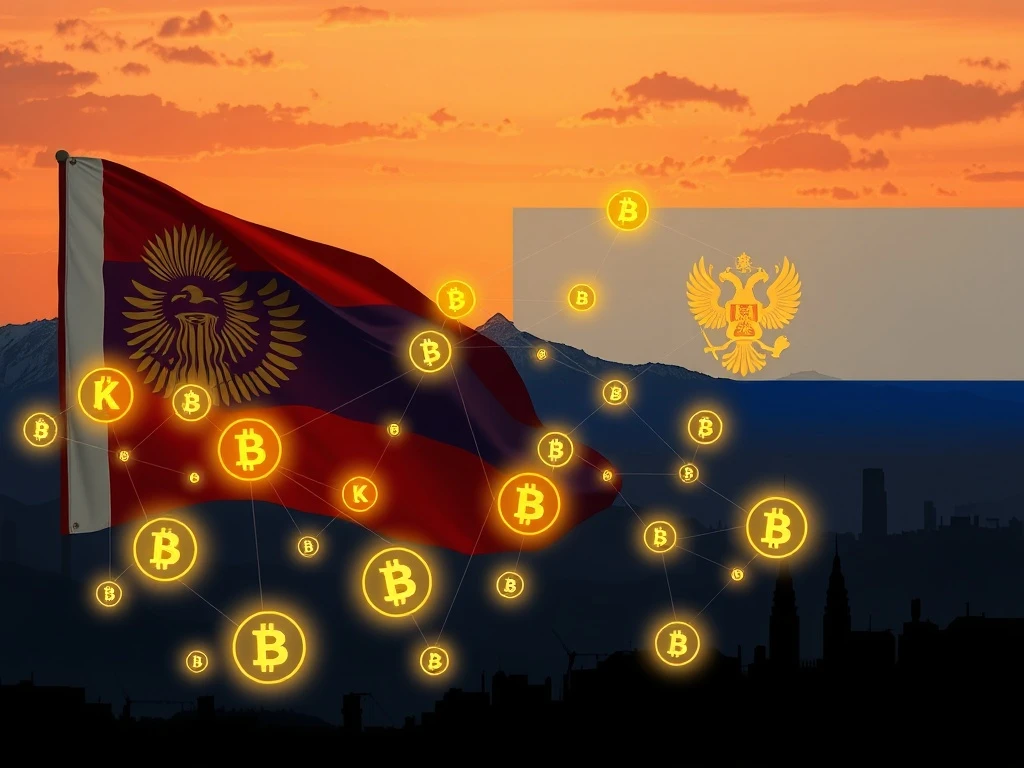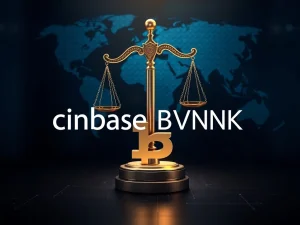Kyrgyzstan Crypto: Unveiling the Alarming Loophole for Russian Sanctions Evasion via Stablecoins

In the evolving landscape of global finance, cryptocurrencies often present a double-edged sword. While promising innovation and financial inclusion, they can also become tools for illicit activities. A recent investigation has cast a spotlight on how Kyrgyzstan crypto infrastructure is reportedly being leveraged by Russian entities to circumvent international sanctions. This alarming development raises critical questions about the effectiveness of global financial restrictions and the adaptability of those seeking to bypass them.
The Unveiling: What the TRM Labs Report Reveals
A comprehensive report by TRM Labs, a prominent British blockchain intelligence firm, has brought to light concerning details regarding the use of Kyrgyzstan’s cryptocurrency ecosystem. The analysis indicates that Russian entities are actively exploiting this infrastructure to evade the international sanctions imposed following recent geopolitical events. This isn’t just about moving money; it’s about undermining a global effort to curb illicit financial flows.
- Key Platforms Identified: The report specifically names Kyrgyz-based platforms such as Grinex, Meer, and EVDE.
- Russian Connections: These platforms are reportedly linked to Russian exchanges like Garantex, which has already faced bans from Western regulators.
- Mechanism of Evasion: The primary method involves facilitating ruble-to-crypto conversions, predominantly through stablecoins like A7A5. This allows sanctioned individuals and groups to bypass traditional financial restrictions with relative ease.
TRM Labs’ findings are bolstered by suspicious operational overlaps among these Kyrgyz exchanges, including shared addresses, founders, and contact details. For instance, Grinex reportedly began allowing A7A5 withdrawals mere days after Garantex’s shutdown in March 2025, suggesting a coordinated effort to maintain continuity of operations. Experts suspect many of these platforms might be shell firms specifically designed to obscure transaction trails and evade detection.
How Does Stablecoin Evasion Work in Practice?
The use of stablecoins like A7A5 is central to this evasion strategy. Stablecoins are cryptocurrencies designed to maintain a stable value, often pegged to fiat currencies like the US dollar. This stability makes them ideal intermediaries for converting traditional currency (like the Russian ruble) into digital assets, which can then be moved across borders with greater anonymity and speed than traditional banking channels.
The process typically involves:
- Ruble Conversion: Sanctioned Russian entities deposit rubles into Kyrgyz-based platforms.
- Stablecoin Acquisition: These rubles are then converted into stablecoins (e.g., A7A5).
- Cross-Border Movement: The stablecoins can then be transferred globally, often to other crypto exchanges or wallets, effectively bypassing traditional financial intermediaries that enforce sanctions.
- Fiat Conversion (Optional): Once the stablecoins reach their destination, they can be converted back into local fiat currency or other cryptocurrencies, completing the evasion cycle.
This method provides a layer of obfuscation, making it challenging for regulators to track the origin and destination of funds, especially when multiple platforms and intermediary stablecoins are involved.
Kyrgyzstan’s 2022 Crypto Law: An Open Door for Crypto Sanctions Bypass?
The regulatory environment in Kyrgyzstan has inadvertently facilitated this surge in illicit activity. A 2022 law, intended to foster innovation, formally recognized virtual assets and, crucially, permitted the foreign registration of Virtual Asset Service Providers (VASPs) without requiring in-person visits. This policy has proven highly attractive to Russian entities seeking to establish untraceable crypto services away from stricter jurisdictions.
The impact of this permissive framework is evident in the economic data:
- By 2024, bilateral trade between Russia and Kyrgyzstan surged to an impressive $3.5 billion.
- Russian investments in Kyrgyzstan also saw a significant increase, growing by 23% year-on-year.
While some of this growth may be legitimate, the TRM Labs report suggests a substantial portion is linked to efforts to circumvent sanctions, with Kyrgyzstan acting as a key conduit for these financial flows.
Beyond Finance: The Flow of Dual-Use Goods and Broader Russian Sanctions Evasion
The implications of Kyrgyzstan’s crypto ecosystem extend beyond mere financial transactions. The report also highlights the country’s growing role in channeling dual-use goods to Russia – items that have both civilian and military applications. This is a critical concern for international security, as it could directly support Russia’s military efforts.
- Trade Surge: Chinese exports of sensitive goods like drones, semiconductors, and anti-UAV equipment to Kyrgyzstan and Kazakhstan increased dramatically by 64% between 2022 and 2023, reaching $1.3 billion.
- Masking End Use: These goods are often shipped via Kyrgyzstan to mask their ultimate destination and end use, making it harder for international bodies to enforce export controls.
This suggests a sophisticated network that integrates financial evasion with the physical movement of strategic goods, all facilitated by the loopholes in the Kyrgyz regulatory framework and its growing crypto sector.
The Escalating Challenge of Kyrgyzstan Crypto and Global Financial Stability
The expansion of Kyrgyzstan’s crypto ecosystem has been rapid and significant since the onset of the Russian-Ukrainian war. VASP transaction volumes within the country soared from $59 million in 2022 to an astonishing $4.2 billion in the first seven months of 2024 alone. This explosive growth directly correlates with the heightened demand for alternative financial channels by sanctioned Russian actors.
The continued reliance on stablecoins like A7A5 further complicates tracking efforts, as they serve as opaque intermediaries in ruble conversions. This situation raises serious concerns about:
- The overall effectiveness of international sanctions regimes.
- The rapid adaptability and sophistication of illicit financial networks.
Kyrgyzstan’s strategic geographical location, coupled with its permissive virtual asset regulations, has positioned it as a critical hub for cross-border sanctions evasion. TRM Labs warns that without swift and decisive action, similar tactics could proliferate to other regional jurisdictions, further eroding global financial stability.
Western governments are increasingly urging enhanced collaboration with Kyrgyz authorities to close these regulatory loopholes. Strengthening transparency in regional exchanges and fostering greater international regulatory alignment are deemed essential steps to disrupt these intricate networks and safeguard the integrity of the global financial system. The challenge is immense, but the imperative to act is clear.
Frequently Asked Questions (FAQs)
Q1: What is the main concern highlighted by the TRM Labs report?
The report primarily highlights how Kyrgyzstan’s cryptocurrency infrastructure, enabled by its 2022 crypto law, is being exploited by Russian entities to evade international sanctions, particularly through the use of stablecoins for ruble-to-crypto conversions.
Q2: Which specific platforms are implicated in the sanctions evasion?
Kyrgyz-based platforms like Grinex, Meer, and EVDE are identified in the report. These platforms are linked to Russian exchanges, such as Garantex, which has previously been sanctioned by Western regulators.
Q3: How does Kyrgyzstan’s 2022 crypto law contribute to this issue?
The 2022 law recognized virtual assets and, crucially, allowed foreign Virtual Asset Service Providers (VASPs) to register without requiring in-person visits. This permissive regulatory environment has attracted Russian entities seeking less traceable crypto services.
Q4: Are only financial transactions being evaded, or are there other concerns?
Beyond financial transactions, the report also indicates that Kyrgyzstan is playing a role in channeling dual-use goods (items with both civilian and military applications) to Russia. Chinese exports of such goods to Kyrgyzstan and Kazakhstan have significantly increased, often shipped through Kyrgyzstan to mask their end use.
Q5: What measures are being suggested to counter this evasion?
Western governments are calling for increased collaboration with Kyrgyz authorities to close regulatory loopholes. Key suggestions include strengthening transparency in regional exchanges and enhancing international regulatory alignment to disrupt these illicit financial networks.







